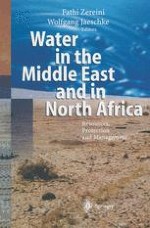2004 | OriginalPaper | Buchkapitel
Hydrogeological Investigations in the North-Eastern Dead Sea Area, Suweimeh, Jordan
verfasst von : W. Ali, J. Glaser, M. Thiel, H. Hötzl, H. Werz
Erschienen in: Water in the Middle East and in North Africa
Verlag: Springer Berlin Heidelberg
Enthalten in: Professional Book Archive
Aktivieren Sie unsere intelligente Suche, um passende Fachinhalte oder Patente zu finden.
Wählen Sie Textabschnitte aus um mit Künstlicher Intelligenz passenden Patente zu finden. powered by
Markieren Sie Textabschnitte, um KI-gestützt weitere passende Inhalte zu finden. powered by
The Sweimeh Area at the north-eastern shoreline of the Dead Sea represents the margin between the Jordan Valley to the west and the escarpment of the Jordan mountains to the east. This study is a part of the activity of the Karlsruhe team within the course of the Multinational BMBF Joint Research Project Water Resources Evaluation for a Sustainable Development in the Jordan Rift Basin as part of the German — Israeli — Jordanian — Palestinian Joint Research Program, 2nd PhaseThe objective of this study is the detailed knowledge and the understanding of the hydrogeological conditions along the cross section from Jerusalem to Amman via Jericho.The outcropping formations in the study area range from the Triassic Zerqa Ma’in Group to the Quaternary Lisan Marl Formation and young basaltic flows. The study area is structurally intensively affected by the development of the Jordan Rift Graben System.Hydrogeologically, the area comprises the three regional important aquifer complexes of Jordan. The Zerqa Ma’in and the Kurnub Sandstone Group are summarised within the Deep Sandstone Aquifer Complex, the Ajlun Group belongs to the Upper Cretaceous Aquifer Complex and the alluvial deposits together with the basalts build the Shallow Aquifer Complex.15 springs are hydrochemically investigated in the Sweimeh area. The results show a dramatical increase of salinization from the east towards the Dead Sea in the West of the study area. Additionally, the results show very different chemical compositions. Therefore, two main groups of springs can be distinguished. All spring waters have a high content of TDS which are classified as medium saline to brine. In all springs a fluctuation of cation distribution is observed between two work sample cycles within a time of two weeks. Ionic ratios show different origins and influences of the spring waters. The investigation of stable isotopes confirm the differences in the spring water composition.The execution of pumping tests close to the study area in Wadi Kafrien permitted the determination of the hydraulic parameters of the Kurnub Sandstone Formation. The evaluation resulted transmissivities in a range from 1,34*10−3 m2/s to 7,97*10−3 m2/s.
